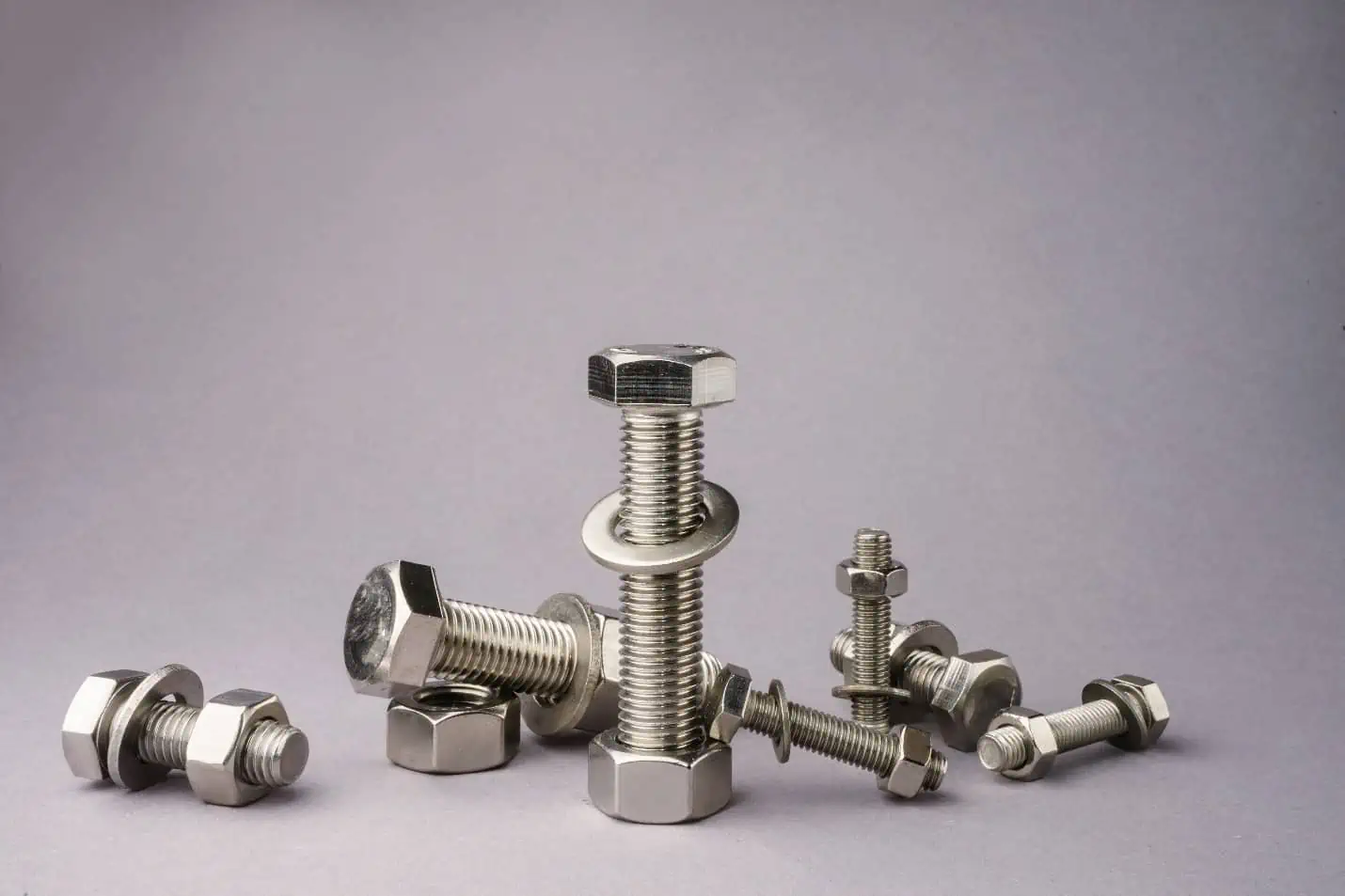Bolt grades are essential for ensuring that bolted joints are strong and durable enough to handle the intended load with the appropriate safety factor. These alphanumeric designations categorize bolts based on their mechanical properties, such as proof load, tensile strength, and surface hardness.

Continue reading as we dive into the basics of bolt grades and their standards, including SAE, ASTM, and metric bolt grades, as well as non-ferrous bolt grades.
Bolt Grades Explained
Bolt grades are alphanumeric designations that categorize bolts based on their mechanical properties. They determine the maximum amount of load the bolt can handle as well as the method that can be used for tightening the bolt. In general, the higher the grade number, the stronger the bolt.
The grades are typically indicated by markings engraved on top of the bolt head, which may show up as raised numbers or dashes. These designations assist engineers in choosing bolts appropriate for specific applications. Selecting the correct grade of bolt ensures a strong and durable joint that is capable of handling the intended load with the appropriate safety factor.

Elevate Your Engineering With Excel
Advance in Excel with engineering-focused training that equips you with the skills to streamline projects and accelerate your career.
The properties involved in bolt grade classification normally include proof load, tensile strength, yield strength, elongation, area reduction, surface hardness, and core hardness. However, it is important to note that not all standards encompass all of these properties.
Proof load refers to the amount of tensile stress a bolt can withstand for a specified minimum duration without permanent deformation. On the other hand, yield strength indicates the stress level at which a bolt permanently deforms by a specified percentage of the gage length. Typically, the proof load falls between 85% and 95% of the yield strength.

Tensile strength represents the stress at which a bolt fractures. It is crucial to ensure that, during testing, the fracture does not occur at the junction of the bolt’s head and body. This requirement ensures the integrity of the junction.
The elongation and area reduction represent the percent change in length and cross-sectional area of the bolt, respectively, at the point at which it breaks during mechanical testing. Lastly, the hardness is a measure of the bolt material’s resistance to indentation or penetration. Normally, it is measured using Rockwell hardness testing, which is performed by measuring the depth of indentation made by an indenter to determine the hardness value based on a specified scale.
During the heat treatment process, a thin layer of carburized material may form on the part’s surface. This layer is usually harder and more brittle compared to the material in the rest of the part. Therefore, standards usually establish distinct hardness requirements for the surface and core of the bolt.
To prevent brittleness, many specifications establish a maximum surface hardness value, which can be non-destructively tested on either the unthreaded shank or the head of the bolt. In contrast, core hardness testing necessitates cutting the part to examine its interior cross-section, which makes core hardness tests destructive in nature.
Bolt Grade Standards
Steel is the material of choice for over 90% of fasteners due to its inherent strength, excellent workability, and cost-effectiveness compared to other materials. As a result, many bolt grade standards are primarily focused on steel, which can be either low carbon, medium carbon, or alloy steel.
There are three main standards for bolt grades: the classification system established by the Society of Automotive Engineers (SAE), the standard defined by the American Society for Testing and Materials (ASTM), and the metric standard developed by the International Organization for Standardization (ISO).
SAE Bolt Grades
SAE bolts are widely utilized as the standard bolts for automotive, machinery, and OEM applications, particularly in North America. These bolts adhere to the SAE J429 Specifications, established by the Society of Automotive Engineers. The SAE marking system employs raised dashes on the bolt head to signify the bolt grade.
SAE bolt grades are indicated by numbers, where higher numbers correspond to greater tensile strength. Decimals are used to denote variations within the same strength level. Within this standard, bolt grades include Grades 1, 2, 5, 5.2, 8, and 8.2, with nominal sizes ranging from ¼ to 1 ½ inches, depending on the specific bolt grade.
The mechanical properties of the SAE bolt grades are shown on the chart below.
Aside from mechanical properties, SAE has also specified the chemical composition and heat treatment required for each bolt grade. These are shown on the chart below.
Bolts of Grades 1 and 2, crafted from low to medium carbon steel, provide moderate strength and are typically employed in non-critical applications. Grade 5 bolts, made from medium carbon steel, offer greater strength and are suitable for applications that require higher load-bearing capacities. Grade 8 bolts, manufactured from medium carbon alloy steel, deliver the utmost strength which can be useful in heavy machinery and automotive suspensions.
ASTM Bolt Grades
ASTM bolts are used in a wide range of industries, although they are primarily used for construction, infrastructure projects, structural steel connections, and general engineering purposes. Hence, they encompass a variety of bolt types to accommodate different fastening needs, including hex bolts, carriage bolts, anchor bolts, eye bolts, and U-bolts.
ASTM bolt grades are indicated by the letter A followed by three numerals stamped on the bolt head. Some of the most common ASTM bolt specifications are as follows:
- A307 – Low-Carbon Steel Externally and Internally Threaded Standard Fasteners
- A325 – High-Strength Bolds for Structural Steel Joints, Including Suitable Nuts and Plain Hardened Washers
- A354 – Quenched and Tempered Alloy Steel Bolts and Studs with Suitable Nuts A449 – Quenched and Tempered Steel Bolts and Studs
- A490 – Quenched and Tempered Alloy Bolts for Structural Steel Joints
ASTM A307, A325, and A490 are the most common bolt grades.
ASTM A307 bolts, crafted from low carbon steel, are ideal for general-purpose applications. On the other hand, the preferred material specification for conventional heavy hex high-strength bolts in steel-to-steel connections is ASTM A325. However, when higher strength is desired, ASTM A490 can be specified.
For twist-off type tension-control bolt assemblies, ASTM F1852 and ASTM F2280 are the most commonly used grades. ASTM F1852 provides strength comparable to that of ASTM A325 bolts, while ASTM F2280 provides strength comparable to that of ASTM A490 bolts.
The chart below summarizes the applicable ASTM specifications for bolts as well as their corresponding tensile stress values and diameter range.

Metric Bolt Grades
Metric bolts adhere to the globally recognized specifications and standards set by ISO 898-1.
In general, metric bolts are made of carbon steel or alloy steel and feature a triangular ISO metric screw thread in accordance with ISO 68-1. Their diameter and pitch combinations align with ISO 261 and ISO 262, and their thread tolerances conform to ISO 965-1, ISO 965-2, and ISO 965-4.
Metric bolt grades are represented by two numbers separated by a dot, typically displayed as raised or depressed numerals on the bolt head’s top or side. The number to the left of the dot comprises one or two digits and signifies 1/100 of the nominal tensile strength in megapascals (MPa). On the other hand, the number to the right indicates 10 times the ratio between the nominal yield strength and the nominal tensile strength.
To indicate a fastener’s reduced loadability, an additional zero can be added to the left of the marking. This signifies that the fastener’s capacity to carry a load is diminished compared to its intended load-carrying capacity, which can be due to dimensional limitations for some types of fasteners.
For example, if a bolt has a nominal tensile strength equal to 500 MPa and a yield strength ratio of 0.8, its metric bolt grade is 5.8. If the same bolt has a reduced loadability, it can be designated by 05.8.
In general, metric bolts are available in grades 4.6, 4.8, 5.8, 8.8, 9.8, 10.9, and 12.9. Grades 4.6 to 5.8 consist of low or medium carbon steel, while grades 8.8 and 9.8 are composed of quenched and tempered medium carbon steel. Grade 10.9 is made from quenched and tempered low carbon martensite, while grade 12.9 is crafted from quenched and tempered alloy steel.
The mechanical and physical properties of metric bolts are shown on the chart below.
Non-Ferrous Bolt Grades
Bolts are produced from a variety of materials, each with its own distinct mechanical properties. While steel is the predominant choice in the industry, other metals such as copper, aluminum, titanium, and nickel alloys can also be utilized for specialized bolt applications.
Copper bolts are commonly used in electrical installations, grounding systems, and high-temperature applications where efficient heat dissipation is necessary. Aluminum bolts are lightweight and corrosion-resistant; hence, they are used in industries such as in automotive and sports equipment where weight reduction is crucial.
Titanium bolts offer exceptional strength-to-weight ratios which are crucial in aerospace and medical applications. Lastly, nickel alloy bolts are known for their exceptional resistance to corrosion and high-temperature environments; hence, they are commonly used in industries such as chemical processing, petrochemical, and power generation.
The most commonly used standard for non-ferrous bolts is the ASTM F468. The mechanical properties of non-ferrous bolts, as stated in this standard, are shown on the chart below.
Aside from ASTM F468, there is also a Chinese national standard known as GB/T 3098.10, which specifies the mechanical properties of fasteners made of non-ferrous metals, particularly copper and aluminum alloys. In this standard, bolts made of copper and copper alloys are available in grades CU1, CU2, CU3, CU4, CU5, CU6, and CU7; while bolts made of aluminum and aluminum alloy are available in grades AL1, AL2, AL3, AL4, AL5, and AL6.
The minimum tensile load of the different copper and aluminum bolt grades according to GB/T 3098.10 are shown in the table below.
